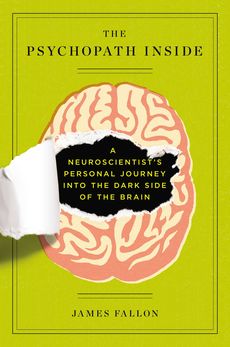Psychopathy
How To Think Like a Psychopath
An interview with James Fallon, author of "The Psychopath Inside"
Posted November 25, 2013

I recently had the chance to speak with neuroscientist James Fallon, Ph.D. whose book “The Psychopath Inside” came out this month. In the book, Fallon details his discovery that his brain function resembles a psychopath’s. Psychopathy is defined by a constellation of traits, including callousness, interpersonal manipulation, impulsivity and criminal tendencies. Psychopathy has been an interest of mine for several years, so it was great to talk with a fellow brain nerd about what causes it, how it manifests, and why it exists at all. Here’s what he had to say.
James Fallon: A lot of my diagnosis came from conversations with psychiatrists who are quite hip on it and know me intimately. One thing had to do with my reaction to stress, things that universally people become quite bothered by. When I get stopped by cops, I’m cool as a cucumber.
Psychiatrist friends would ask me, “You don’t have any tells that would betray your feelings, anxiety. How did you make believe you didn’t feel that?”
I said, “Actually, I don’t feel anything.”
Joshua Gowin: Is that common?
JF: When I started talking about this, with the Ted talk, and the Moth, I got thousands of emails from people saying they or their husband is just like that, but they didn’t know it was abnormal. I said, maybe it isn’t. Maybe they’re just at the end of some of these spectrums. I think a lotta guys and some women are like this, but they just hide it.
JG: In the book you call yourself a prosocial psychopath.
JF: I had to come up with something to call what I have. I’m like at a 20 on the Hare scale. [author’s note: To meet criteria for psychopathy, you must score over 30. Most people are below 10]. A lot of the things I did when I was younger—blowing up pipe bombs, stealing things, breaking into houses—at the time, it was the cultural norm. You were just a prankster. So instead of being a 24, 25, I was downgraded to a 20. Even as a professor, I’ll get in trouble. And when I’ve been caught, the police always let me go, because I’d get them laughing and I didn’t look that guilty. They would downgrade mayhem and felony into, “Don’t do that again.” That objective, antisocial criminality, have-you-been-in-jail stuff? I don’t have that because I’ve been able to fend off being caught.
I would be considered prosocial because most of the things I do are quite positive to other people. I’m involved in charity, I give anonymously, I’m involved in leadership roles. I get a kick out of helping. I get a buzz from look-what-I-can-do-for-the-world as opposed to being a real good guy. I would rather be a real good guy, but I think a lot of it is fed from that fire of ego and narcissism.
But as far as I can measure people’s behaviors when they love someone, I don’t do those. I live in an emotional flatland. I care as much, empathetically, about my own granddaughter, as I do a stranger on the streets of Mumbai. But it’s not flat, nothing; it’s ok. If I see a sick kid I can actually start to cry. But I have no more than that. One psychiatrist I met said “That’s completely Buddhist. They care the exact same about everybody.” And I said, “But it’s so disappointing to people close to you.” You don’t want to be married to me or be my kid or close friend because I’ll kind of dump you, and I don’t even think about it.
JG: So if you come out as being a prosocial psychopath, doesn’t that take away the element of surprise now? You can’t sneak up on people anymore.
JF: That’s good, what can I get away with now? Nothing. Unless people like being manipulated. Some people find it exciting.
I’m not a full blown psychopath on any scale. What I am is a prosocial borderline psychopath because I’ve been lucky in so many ways. My family I was born into, who I married, on and on. That’s why I consider what I would have been without that. I don’t think I would have turned out too well.
JG: That goes into an idea you talked about, a three-legged stool that supports development into a healthy adult. One leg is your genetics, right? And another is your upbringing and environment, is that correct?
JF: The three-legged stool idea was personal—to explain my own behavior—but I tried to generalize it.
But the second leg was, all of the murders I looked at, I saw consistent deactivation with the anterior cingulate cortex, the orbitofrontal cortex and amygdala. I went, “Holy shit, there’s a pattern. It’s those two things [genetics and lowered brain activation].” I had read a couple case reports on orbital cortex damage, 2 year olds run over by a car and all the stuff, and I said wow, so you can get it by early damage.
At the time I said, “Can the combination of monoaminergic alleles mimic a lesion?” I was looking at the articles by Caspi showing the behavioral genetics, but also Meyer Lindenberg. He showed the impact on the structural reactivity of orbitofrontal cortex and amygdala. You can get a sort of mimicked [brain] lesion just by the combination of many high risk alleles. SRT, MAOA, B and warrior gene and others. So I said “OK, you can get it either way, with damage or trauma to the brain, or by a rare combination of a lot of those genes that change the reactivity of the structures in question.”
I remember Amy Arnsten, a prefrontal expert and an old friend, saw my TED talk. She called me and said, “Jim, that is really pathological. Check your 5HT-2A allele. You could have a combination of alleles that affect serotonin and dopamine that might turn off parts of your cortex. It’s probably not a structural lesion. It’s a combinatorial, allelic lesion.”
I think she’s right. I mentioned her in the book but I didn’t want to curse her with having to live with my diagnosis.
That was the second leg. The anatomical pattern of loss you can get a couple of ways, either genetic or environmental. I didn’t go into it much in the book because that would confuse people.
The third leg is abuse. When I was writing the book, I started looking at the SRT data. The science people were doing started to make sense in my own life, as to why I turned out rather positively. My genetics is really awful. I have almost no activity in those limbic and frontal areas. With the right SRT genes, if you’re exposed to a positive early environment, like I was, it can have the opposite effect. It wasn’t a risk at all, it was saving. That really pumped me.
JG: How does your theory differ from a nature-nurture and their interaction view of things?
JF: It is the nature-nurture interaction, and of course timing. Most things have been thought of for thousands of years. The issue is, how do you prove it? As an anatomist, I said, “What are the details?” Getting those in a tight story was the interesting thing. I didn’t invent that idea at all; I’m just trying to put this story together in a way that I was satisfied with scientifically.
JG: It’s hard to spot a psychopath. The most famous book on psychopathy is called “The Mask of Sanity,” because psychopaths blend in so well. They don’t look crazy. As someone with a score in the 20s, do you think it takes one to know one? Can a psychopath identify another psychopath?
JF: I will meet people at bars and start talking to them and I see a few tells. One of the tells, by the way, is the lack of tells. I’ll catch the eye of someone, and I get the real strong feeling that they’re one of em. I certainly can see some characteristics that are telling.
JG: The main one being the lack of tells?
JF: The lack of tells and how they interact with people. The difference between salesmanship, a bullshitter, and the way a good psychopath will manipulate people. It takes about 15 minutes. Like with schizophrenics, you don’t know they’re schizophrenic until after 15 minutes, they start getting weird. Or someone with Alzheimers, they repeat the same story again.
For psychopaths, they practice all this stuff. It’s in that 15 to 20 minute range that things will start popping up. Somebody else may come into the conversation and they’ll use the same manipulative technique to get into their heads, but beyond normal, in an inappropriate way. It’s beyond just salesmanship, because salesmen will use the same technique over and over again, too. But someone who’s really reading people, they will change it a little bit. You can see something similar, but they’ve looked at that person enough, read their weaknesses, so they modify it. That, I think, is a tell.
JG: Finally, who would you rather have a beer with, Hannibal Lecter or Ted Bundy?

JF: Well, the first Hannibal Lecter is the greatest. I would like to have dinner with him and Will Grant, a real prosocial psychopath. That pair would be the greatest to sit down with as real people and see, go through, and talk about each one of these traits, where they fit and how. We’d get each other’s pulse and get drunk and see how it degenerated after that. Ted Bundy’s an asshole.




